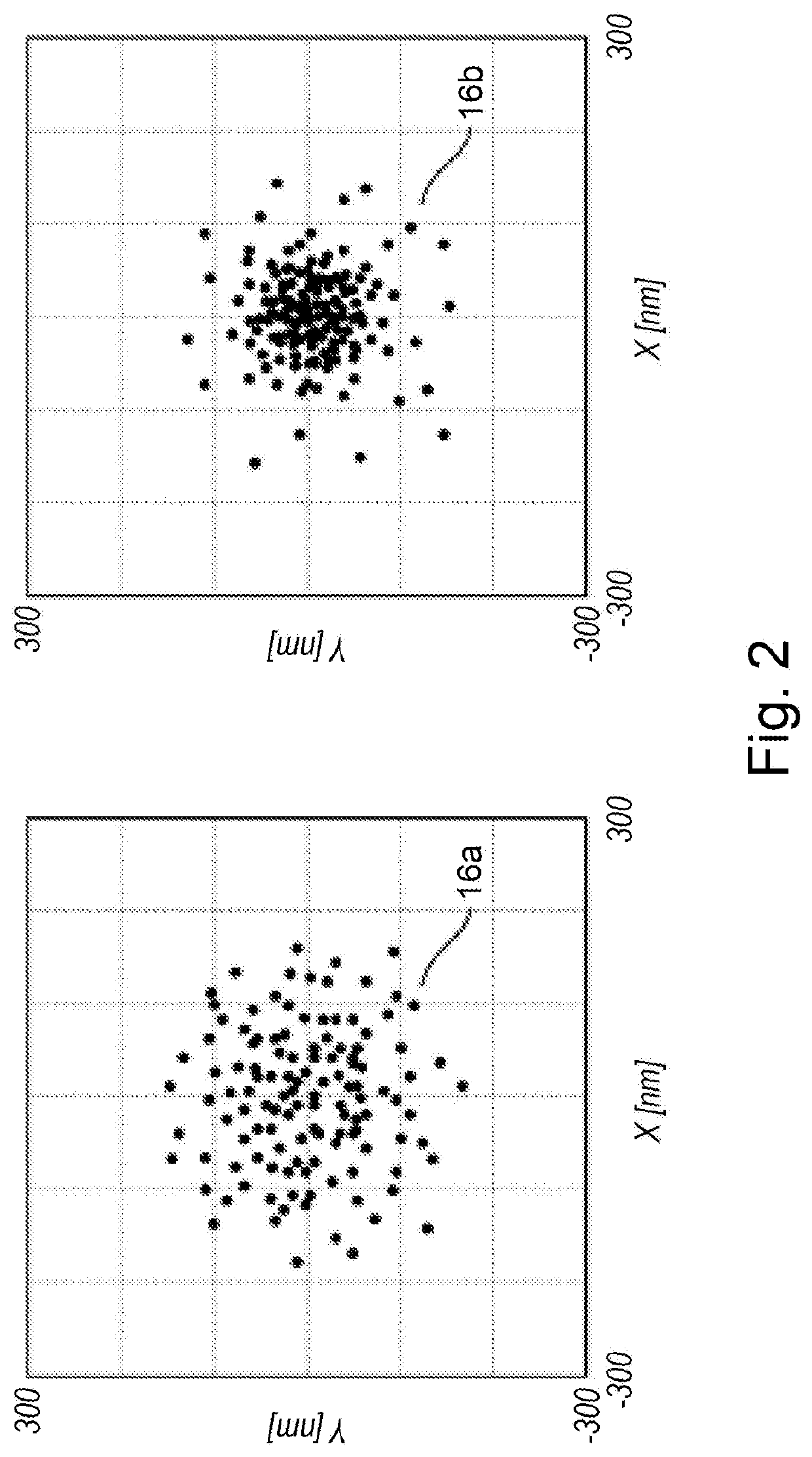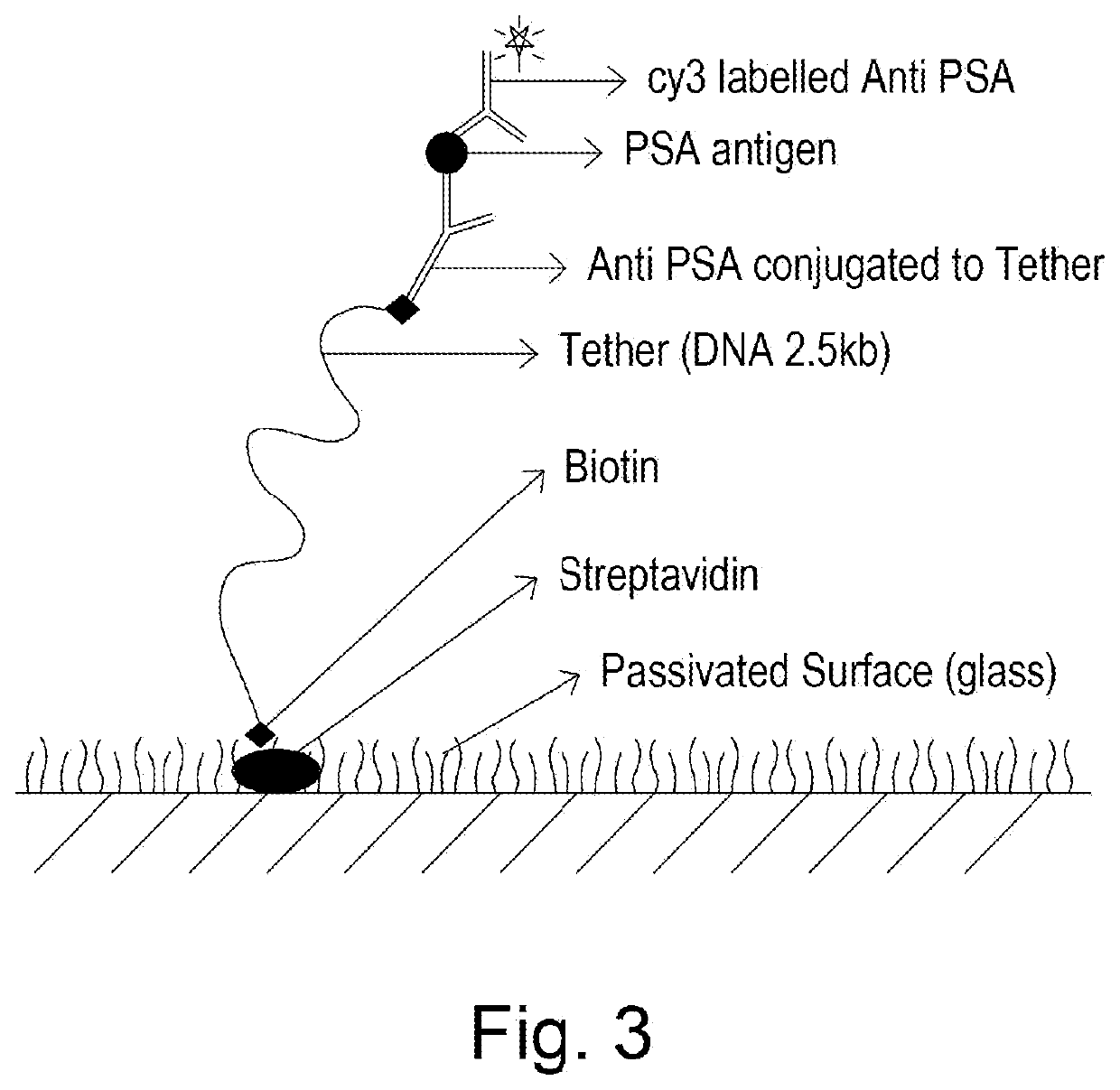Imaging assays
a technology of assays and images, applied in the field of assays, can solve the problems of inability to detect biomarkers, same problems of detection and diagnosis, and techniques suffer from drawbacks, so as to increase the mass of marker species and increase the scattering of light
- Summary
- Abstract
- Description
- Claims
- Application Information
AI Technical Summary
Benefits of technology
Problems solved by technology
Method used
Image
Examples
example 1
[0172]FIG. 1 shows an illustrative embodiment of a method according to the invention. In this embodiment, an assay is performed on the surface of a glass support (1). A total internal reflection (TIR) illumination scheme (2) is employed. TIR generates an evanescent illumination field that decays exponentially within a few hundred nanometres of the interface (illustrated on the right of the Figure). The medium can be conceptually divided into regions of high (3a), intermediate (3b) and low (3c) illumination density. The surface of (1) is silanized and passivated using biotinylated BSA (4a) and Tween-20 (4b). Interaction (5), which can, for instance, be a covalent bond or a biotin-streptavidin-biotin interaction, leads to the binding of a 1 kb dsDNA tether (6) to the surface (1) via BSA (4a). Interaction (7), which can, for instance, be a biotin-streptavidin-biotin interaction, binds capture antibodies (8) onto the dsDNA tether.
[0173]A serum sample was loaded onto the functionalized s...
example 2
[0176]This example illustrates a simple protocol for the passivation of a microscope slide or coverslip. This protocol may also be employed for treating microfluidic chips.
[0177]The coverslip is placed in a staining jar and rinsed with ultrapure water. The staining jar is then filled with fresh high-purity acetone in order to remove any organic compounds which might otherwise interfere with fluorescence measurements. The staining jar containing the coverslip and acetone is placed in a sonicator and sonicated for about 20 minutes. Following sonication, the acetone is discarded and the coverslip rinsed again with ultrapure water. After rinsing, the staining jar is filled with 1M KOH and sonicated again for about 20 minutes. The KOH is discarded and the coverslip is rinsed again with ultrapure water. A further sonication step of about 20 minutes is performed with the coverslip immersed in ultrapure water and then the coverslip is dried using nitrogen gas. Optionally, the coverslip may ...
example 3
[0182]This Example illustrates one possible implementation of the method of the invention.
[0183]dsDNA is employed as a tether molecule in this Example, although this protocol can be adapted for use with any suitable tether. A passivated microfluidic chamber is employed as the solid support, although this protocol can also be adapted for any form of solid support contemplated herein. The microfluidic chamber may be passivated according to the protocol described in Example 2, for instance.
[0184]The concentration of dsDNA solution is optimised to allow about 300 to 400 tether molecules to be immobilised on the solid support. The tether molecule solution is introduced into the microfluidic chamber and incubated for about 2 minutes. Unbound tether molecules are removed by washing with an appropriate buffer and then 50 μl of a 10 nM solution of the first proximity probe are introduced into the microfluidic chamber. This solution is incubated for about 5 minutes and then any unbound probe ...
PUM
| Property | Measurement | Unit |
|---|---|---|
| mean end-to-end distance | aaaaa | aaaaa |
| volume | aaaaa | aaaaa |
| volume | aaaaa | aaaaa |
Abstract
Description
Claims
Application Information
 Login to View More
Login to View More - R&D
- Intellectual Property
- Life Sciences
- Materials
- Tech Scout
- Unparalleled Data Quality
- Higher Quality Content
- 60% Fewer Hallucinations
Browse by: Latest US Patents, China's latest patents, Technical Efficacy Thesaurus, Application Domain, Technology Topic, Popular Technical Reports.
© 2025 PatSnap. All rights reserved.Legal|Privacy policy|Modern Slavery Act Transparency Statement|Sitemap|About US| Contact US: help@patsnap.com



